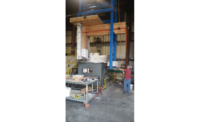Mass-Timber Furnished Apartments Fare Well in Fire Tests

Apartments, with either exposed or protected timber, performed as expected in fires.
PHOTO TOP BY SAM ZELINKA (FPL)

Apartments, with either exposed or protected timber, performed as expected in fires.
PHOTO BY AMERICAN WOOD COUNCIL

The furnished apartments (next photo) had load-bearing mass-timber exterior walls (above).
PHOTO BY FOREST SERVICE

The furnished apartments (above) had load-bearing mass-timber exterior walls (previous photo).
PHOTO BY FOREST SERVICE




Advocates for a code change that would allow taller heavy-timber frames are buoyed by the good performance of mass-timber structures in the first U.S. fire tests on full-scale furnished apartments.
“The tests went as expected,” says Stephen DiGiovanni, fire protection engineer for Nevada’s Clark County Dept. of Building and Fire Protection.
DiGiovanni, also chairman of the International Code Council’s 17-member ad hoc committee for tall wood buildings, plans to use the final test report to help justify a code change that would allow wood frames as tall as 180 ft, depending on building design and use.
The report is due out before Jan. 8, the deadline for code-change proposals for the 2021 edition of the International Building Code. IBC currently limits the height of heavy-timber structures to 85 ft.
Under the likely code-change proposal, the maximum height for mass timber, fully protected with noncombustible sheathing, would be 180 ft. A height of 120 ft would be allowed for mass timber, mostly protected with noncombustible sheathing but with a certain percentage of exposed walls and ceilings. The maximum height of fully exposed mass timber would likely remain at 85 ft, says DiGiovanni.
The ICC committee provided the five fire scenarios tested in the two stacked and identical one-bedroom apartments, each 30-ft square in plan. Tests were conducted at the U.S. Bureau of Alcohol, Tobacco, Firearms and Explosives Fire Research Laboratory.
Funding for the research is from the U.S. Dept. of Agriculture’s Forest Products Laboratory and the American Wood Council (AWC), which supports wood-product manufacturing.
Cost details were not released. However, Samuel Zelinka, the project leader at the Forest Products Laboratory, says the cost will be about $500,000 to $1 million. Much of the funds are from AWC, which paid Lendlease to build and rehabilitate the test specimen.
The specimen’s structure consisted of glue-laminated-timber beams and cross-laminated-timber walls and floor systems. All vertical load-bearing CLT, 7 in. thick, was on the exterior.
One level was tested at a time, says Zelinka. The fire load was 570 MJ/m².
In the first test, researchers subjected a mass-timber structure, fully protected with 5⁄8-in.-thick gypsum wallboard, to a large furnishings-and-contents fire. After three hours, the test was ended without significant charring on the protected wood surfaces.
In the next, four-hour test, about 30% of the CLT ceiling area in the living room and bedroom was exposed. Once the fire consumed the furnishings and contents, the exposed CLT essentially self-extinguished due to the formation of surface char.
The third test exposed parallel CLT walls, one in each room, to the fire. Again, mass-timber surfaces essentially self-extinguished due to the formation of char. In most cases, the char did not move past the first ply of the five-ply CLT, says Zelinka.
Tests Nos. 4 and 5 examined the effects of sprinkler protection on exposed mass-timber surfaces in both rooms. In the fourth test, a single sprinkler, operating normally, easily contained the fire. For the last test, the fire was allowed to grow in the compartment for 23 minutes before water was supplied to the sprinklers. The sprinklers quickly controlled the fire, which Zelinka says was the “most surprising” positive result in the test series.
Under all the conditions tested, the CLT performed “very well,” he adds.
DiGiovanni says the tests are “getting to the same result” as assembly fire tests performed for the 12-story Framework building, under construction in Portland, Ore. (ENR 10/24/16 p. 24). But the Framework tests “were proprietary and specific,” he says. “Ours are generic and will have wider application.”











